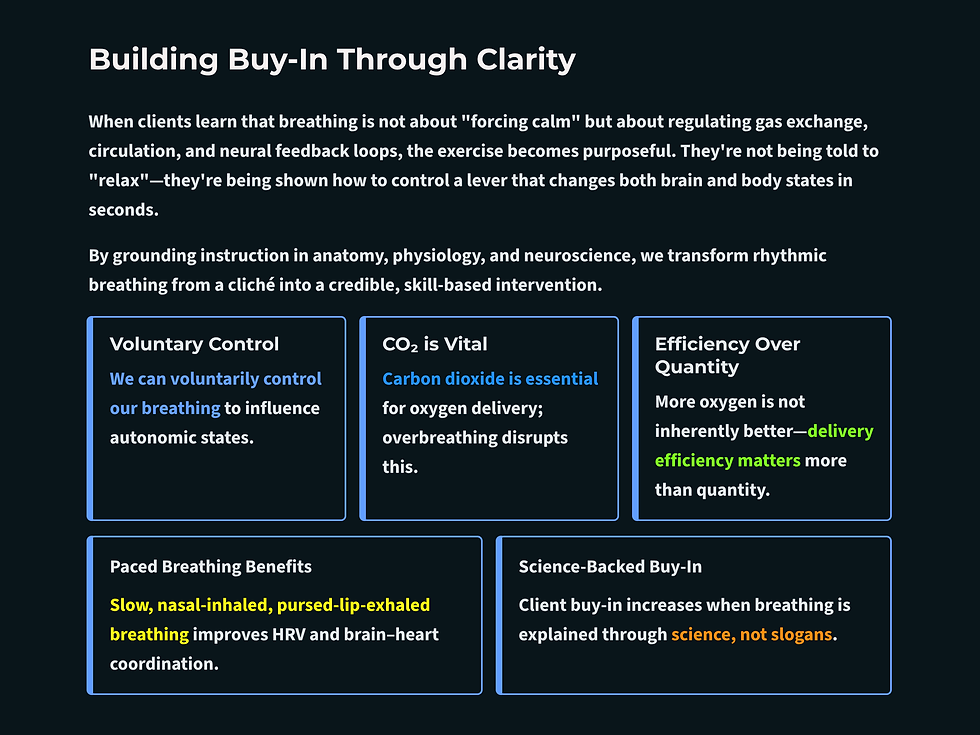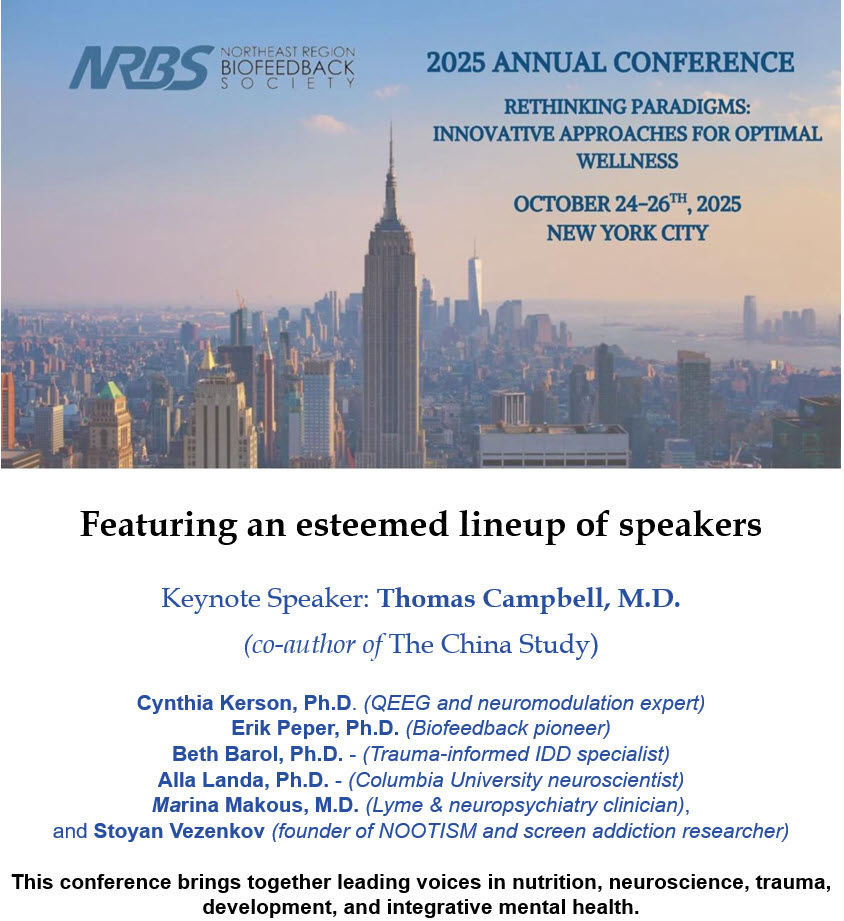Slow Paced Breathing Isn’t “Just Breathing”
- Zachary Meehan

- Aug 9
- 5 min read
Updated: Sep 23

Picture this: a stressed person, chest tight, mind spiraling, is told, “Just take a deep breath.” It’s become a cliché, but it can also feel dismissive—like a physician telling a patient to lose weight without providing a roadmap and resources.
Yet, when guided with curiosity and clarity, breathing becomes a precision tool: a direct bridge to the autonomic nervous system, that largely inaccessible network governing heart rate, blood pressure, and emotional states.
Breathing holds a rare duality—it’s involuntary and voluntary—allowing us to step into our own physiology and intentionally steer it. When clients practice rhythmic breathing—calm, intentional, and grounded—they engage the vagus nerve, inviting a shift toward parasympathetic dominance, where safety cues replace threat signals.
Slow, paced breathing doesn’t merely “calm you down”; it directly modulates brain regions such as the anterior insula and medial prefrontal cortex, which coordinate cardiovascular control and emotional regulation (Critchley et al., 2015; Huber et al., 2025).
This is why, in the right hands, breathing becomes an immediate way to interrupt panic cascades and restore balance.
Dispelling Myths to Strengthen Credibility
Before clients can trust their breath, they need to unlearn misinformation.
Myth 1: “Carbon dioxide is just a waste gas.”
In truth, carbon dioxide (CO₂) is essential for delivering oxygen to tissues through the Bohr effect—where hemoglobin’s affinity for oxygen decreases in the presence of CO₂, allowing oxygen release where it’s needed most (Malte & Lykkeboe, 2018).
Overbreathing lowers CO₂, raises blood pH, and keeps oxygen bound to hemoglobin, effectively starving tissues, including the brain, of oxygen (Khazan, 2021).
Myth 2: “More oxygen is always better.”
At rest, blood oxygen saturation is typically 95–100%. The issue in stress isn’t a shortage of oxygen in the blood, but whether oxygen is released efficiently to tissues (Jensen, 2004; Malte & Lykkeboe, 2018).
Overemphasizing “getting more oxygen” often leads to excessive inhalation and loss of CO₂, undermining oxygen delivery and triggering symptoms like dizziness, chest tightness, or heightened anxiety.
Debunking these myths positions breathing as an evidence-based skill, not an airy abstraction.
A Simple, Evidence-Based Approach
The science supports an accessible starting point: slow nasal inhalation for about 5 seconds, gentle pursed-lip exhalation for about 5–6 seconds, repeated for 5–10 cycles. This approach, practiced at roughly 5.5–6 breaths per minute, consistently increases heart rate variability (HRV), enhances vagal tone, and strengthens brain–heart coupling (Huber et al., 2025; Lin et al., 2014; Zaccaro et al., 2018).
The nose is the preferred route for inhalation when medically advisable—not just for filtration and humidification, but because nasal breathing boosts nitric oxide levels, which dilate blood vessels and improve oxygen distribution (Kimberly et al., 1996). Pursed-lip exhalation slows airflow, supporting CO₂ retention and giving the nervous system time to shift toward balance.
Why Slow Paced Breathing Works
Slow, intentional breathing optimizes the ratio of oxygen to CO₂, stabilizes blood pH, and enhances nitric oxide–mediated vasodilation.
Functional neuroimaging shows that such breathing activates the thalamus, anterior insula, and medial cingulate gyrus—key hubs of the central autonomic network (Huber et al., 2025).
These areas integrate interoceptive awareness with cardiovascular control, helping the brain coordinate both arousal and recovery phases.
This coupling is not just theoretical—Huber et al. (2025) demonstrated predictive, bidirectional relationships between brain activation and HRV during both stress and recovery. In essence, breathing shapes the heart’s rhythm, and that rhythm shapes the brain’s state.
Building Buy-In Through Clarity
When clients learn that breathing is not about “forcing calm” but about regulating gas exchange, circulation, and neural feedback loops, the exercise becomes purposeful. They’re not being told to “relax”—they’re being shown how to control a lever that changes both brain and body states in seconds.
By grounding instruction in anatomy, physiology, and neuroscience, we transform rhythmic breathing from a cliché into a credible, skill-based intervention.
Five Key Takeaways
We can voluntarily control our breathing to influence autonomic states in real time.
Carbon dioxide is vital for oxygen delivery; overbreathing disrupts this balance.
More oxygen is not inherently better—delivery efficiency matters more than quantity.
Slow, nasal-inhaled, pursed-lip-exhaled breathing at ~5.5–6 breaths/min improves HRV and brain–heart coordination.
Client buy-in increases when breathing is explained through science, not slogans.


Glossary
Bohr effect: a physiological process where hemoglobin releases oxygen more readily in the presence of higher carbon dioxide levels or lower pH.
carbon dioxide (CO₂): a gas produced during metabolism, essential for maintaining blood pH and enabling oxygen release to tissues.
central autonomic network (CAN): a set of brain regions that regulate autonomic functions like heart rate and blood pressure.
heart rate variability (HRV): the variation in time between consecutive heartbeats, reflecting autonomic nervous system adaptability.
nitric oxide: a signaling molecule that dilates blood vessels, enhancing blood flow and oxygen delivery.
overbreathing: a mismatch between breathing rate and depth that causes excessive exhalation of carbon dioxide, disrupting blood pH and reducing oxygen delivery to tissues.
vagus nerve: the tenth cranial nerve, central to parasympathetic regulation of heart rate, digestion, and mood.
References
Critchley, H. D., Nicotra, A., Chiesa, P. A., Nagai, Y., Gray, M. A., Minati, L., Bernardi, L., Devoto, J., Truemper, E. J., Lopresti, M. L., & Vanello, N. (2015). Slow breathing and hypoxic challenge: Cardiorespiratory consequences and their central neural substrates. PLoS ONE, 10(5), e0127082. https://doi.org/10.1371/journal.pone.0127082
Huber, A., Koenig, J., Bruns, B., Bendszus, M., Friederich, H. C., & Simon, J. J. (2025). Brain activation and heart rate variability as markers of autonomic function under stress. Scientific Reports, 15, 28114. https://doi.org/10.1038/s41598-025-12430-8
Jensen, F. B. (2004). Red blood cell pH, the Bohr effect, and other oxygenation-linked phenomena in blood O₂ and CO₂ transport. Acta Physiologica Scandinavica, 182(3), 215–227. https://doi.org/10.1111/j.1365-201X.2004.01361.x
Khazan, I. Z. (2021). Biofeedback and mindfulness in everyday life: Practical solutions for improving your health and performance. W. W. Norton.
Kimberly, B., Nejadnik, B., Giraud, G., Holden, W., & Holden, W. (1996). Nasal contribution to exhaled nitric oxide at rest and during breathholding in humans. American Journal of Respiratory and Critical Care Medicine, 153(2), 829–836. https://doi.org/10.1164/ajrccm.153.2.8564139
Lin, I. M., Tai, L. Y., & Fan, S. Y. (2014). Breathing at a rate of 5.5 breaths per minute with equal inhalation-to-exhalation ratio increases heart rate variability. International Journal of Psychophysiology, 91(3), 206–211. https://doi.org/10.1016/j.ijpsycho.2013.12.006
Malte, H., & Lykkeboe, G. (2018). The Bohr/Haldane effect: A model-based uncovering of the full extent of its impact on O₂ delivery to and CO₂ removal from tissues. Journal of Applied Physiology, 125(3), 916–922. https://doi.org/10.1152/japplphysiol.00249.2018
Zaccaro, A., Piarulli, A., Laurino, M., Garbella, E., Menicucci, D., Neri, B., & Gemignani, A. (2018). How breath-control can change your life: A systematic review on psycho-physiological correlates of slow breathing. Frontiers in Human Neuroscience, 12, 353. https://doi.org/10.3389/fnhum.2018.00353
Author
Zachary Meehan earned his PhD in Clinical Psychology from the University of Delaware and serves as the Clinic Director for the university's Institute for Community Mental Health (ICMH). His clinical research focuses on improving access to high-quality, evidence-based mental health services, bridging gaps between research and practice to benefit underserved communities. Zachary is actively engaged in professional networks, holding membership affiliations with the Association for Behavioral and Cognitive Therapies (ABCT) Dissemination and Implementation Science Special Interest Group (DIS-SIG), the BRIDGE Psychology Network, and the Delaware Project. Zachary joined the staff at Biosource Software to disseminate cutting-edge clinical research to mental health practitioners, furthering his commitment to the accessibility and application of psychological science.

Support Our Friends









Very good and useful information.
Extremely valuable information.